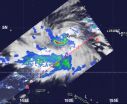(Press-News.org)
VIDEO:
MESSENGER's Mercury Laser Altimeter sends out laser pulses that hit the ground and return to the instrument. The amount of light that returns for each pulse gives the reflectance at...
Click here for more information.
A Goddard-built instrument on NASA's MESSENGER mission provided one of three new lines of evidence that water ice exists near the north pole of Mercury. Most of the ice is covered by a thin layer of material that blankets and protects the ice, but in a few areas where sunlight never reaches, some ice lies exposed on the surface, the researchers announced Nov. 29 in three papers published by Science Express and at a NASA press conference.
The findings are based on reflectance measurements made by the spacecraft's laser altimeter and hydrogen concentrations from the neutron spectrometer as well as new computer modeling that explains how ice could persist for eons on the planet closest to the sun.
"Twenty years ago, radar astronomers made the startling proposal that there is abundant water ice at the poles of our solar system's innermost planet," says Sean Solomon of Columbia University. "But alternative explanations of the radar observations have since been suggested, and the MESSENGER team set a high priority on settling this question with orbital observations. The jury has at last returned a clear verdict." Solomon is the principal investigator for MESSENGER (short for MErcury Surface, Space ENvironment, GEochemistry, and Ranging).
Despite Mercury's proximity to the sun, the north and south polar regions remain cold because they never tilt toward the sun. Evidence for ice deposits at both poles has been building since the early 1990s, when radar studies first spotted areas that looked very bright at radar wavelengths. These "radar-bright" regions suggested that some kind of reflective material lay on or very near the surface, and the locations turned out to be inside impact craters. More recently, extensive imaging by MESSENGER made it possible to match up the radar-bright areas with permanently shadowed regions in craters near the north and south poles.
VIDEO:
Parts of Prokofiev crater (center) and Kandinsky crater (upper left side of Prokofiev) stay in darkness, making it possible for ice to persist on the surface. This time-lapsed animation represents...
Click here for more information.
The new studies focused on Mercury's north pole and the surrounding high latitudes. When researchers measured the reflectance at near-infrared wavelengths using the altimeter, they found more than a hundred dark regions, which reflected less than half the typical amount of light. A few exceptionally bright areas also were detected in the craters named Prokofiev and Kandinsky.
"Nobody had seen these dark regions on Mercury before, so they were mysterious at first," says Goddard's Greg Neumann, lead author of one of the papers in Science Express and an instrument scientist for the Mercury Laser Altimeter. This instrument was built at NASA's Goddard Space Flight Center in Greenbelt, Md.
Because the altimeter's main task is to map the contours of the planet's surface, Neumann and colleagues could see that these unusually dark areas occurred in places that stayed in shadow: on steep crater walls that faced the north pole or on the southern parts of crater floors. The researchers also matched up their dark regions with the reflective areas that looked bright to the radar signals. The regions that appeared radar-bright and unusually bright to the altimeter were located in places that never emerged from shadow.
In the meantime, measurements of hydrogen concentrations made by MESSENGER's Neutron Spectrometer indicated that the radar-bright deposits were water ice. David Lawrence of the Johns Hopkins University Applied Physics Laboratory in Laurel, Md., and colleagues found that the radar-bright areas contain a hydrogen-rich layer buried beneath a layer with less hydrogen.
The results from both instruments made sense if these radar-bright regions (also the altimeter's dark regions) represented water ice covered by a layer of other material. The much rarer bright regions seen by the altimeter would then indicate ice exposed on the surface.
Computer modeling by David Paige of the University of California, Los Angeles, and colleagues showed that Mercury's average temperatures in these areas are low enough for ice to be stable over time. A blanket of insulating material is needed to maintain ice in the altimeter's dark regions, but other spots receive so little sunlight that ice could persist right on the surface.
The ice seems to be the result of a geologically recent or ongoing process, perhaps delivered by comets and other small bodies from the outer solar system. Organic chemicals from those same bodies might make up the material that covers the ice in most places. More work needs to be done before these follow-on questions can be answered definitively.
"But these new findings let us discard the proposals that the radar might be picking up other reflective materials instead of ice," says Neumann. "Now we can focus on understanding the processes that are emplacing volatiles at Mercury's poles."
INFORMATION:
MESSENGER is a NASA-sponsored scientific investigation of the planet Mercury. The principal investigator is Dr. Sean C. Solomon of Columbia University. The Johns Hopkins University Applied Physics Laboratory built and operates the MESSENGER spacecraft and manages this Discovery-class mission for NASA. NASA Goddard built the Mercury Laser Altimeter.
For the related NASA Press release: http://www.nasa.gov/mission_pages/messenger/media/PressConf20121129.html
Altimeter built at Goddard helped identify ice on Mercury
2012-11-30
ELSE PRESS RELEASES FROM THIS DATE:
NASA sees Tropical Storm Bopha moving through Southern Yap state
2012-11-30
VIDEO:
On Nov. 27, 2012, NASA's TRMM satellite revealed that rain in Tropical Storm Bopha was falling at a rate of over 70mm/hour (about 1.75 inches) in the red areas. TRMM...
Click here for more information.
NASA's TRMM and Aqua satellites captured images of Tropical Storm Bopha as it continues to move through Micronesia in the western North Pacific Ocean and trigger warnings and watches throughout.
From its orbit in space, NASA's Tropical Rainfall Measuring Mission ...
Promising drug slows down advance of Parkinson's disease and improves symptoms
2012-11-30
PHILADELPHIA—Treating Parkinson's disease patients with the experimental drug GM1 ganglioside improved symptoms and slowed their progression during a two and a half-year trial, Thomas Jefferson University researchers report in a new study published online November 28 in the Journal of the Neurological Sciences.
Although the precise mechanisms of action of this drug are still unclear, the drug may protect patients' dopamine-producing neurons from dying and at least partially restore their function, thereby increasing levels of dopamine, the key neurochemical missing in ...
Gladstone scientists identify key biological mechanism in multiple sclerosis
2012-11-30
SAN FRANCISCO, CA—November 27, 2012—Scientists at the Gladstone Institutes have defined for the first time a key underlying process implicated in multiple sclerosis (MS)—a disease that causes progressive and irreversible damage to nerve cells in the brain and spinal cord. This discovery offers new hope for the millions who suffer from this debilitating disease for which there is no cure.
Researchers in the laboratory of Gladstone Investigator Katerina Akassoglou, PhD, have identified in animal models precisely how a protein that seeps from the blood into the brain sets ...
A multi-wavelength view of radio galaxy Hercules A
2012-11-30
VIDEO:
Spectacular jets powered by the gravitational energy of a supermassive black hole in the core of the elliptical galaxy Hercules A illustrate the combined imaging power of two of astronomy's...
Click here for more information.
Spectacular jets powered by the gravitational energy of a super massive black hole in the core of the elliptical galaxy Hercules A illustrate the combined imaging power of two of astronomy's cutting-edge tools, the Hubble Space Telescope's ...
Mediation with art therapy can change your brain and lower anxiety
2012-11-30
(PHILADELPHIA) – Cancer and stress go hand-in-hand, and high stress levels can lead to poorer health outcomes in cancer patients. The Jefferson-Myrna Brind Center of Integrative Medicine combined creative art therapy with a Mindfulness-based Stress Reduction (MBSR) program for women with breast cancer and showed changes in brain activity associated with lower stress and anxiety after the eight-week program. Their new study appears in the December issue of the journal Stress and Health.
Daniel Monti, MD, director of the Jefferson-Myrna Brind Center of Integrative Medicine ...
Birds may spread, not halt, fever-bearing ticks
2012-11-30
SALT LAKE CITY, Nov. 30, 2012 – Turkey raises and releases thousands of non-native guineafowl to eat ticks that carry the deadly Crimean-Congo hemorrhagic fever virus. Yet research suggests guineafowl eat few ticks, but carry the parasites on their feathers, possibly spreading the disease they were meant to stop, says a Turkish biologist working at the University of Utah.
"They are introducing a species that is not eating many ticks, based on studies of stomach content, and is carrying the ticks, which are the best conduit for spreading Crimean-Congo hemorrhagic fever," ...
Obese children more vulnerable to food advertising
2012-11-30
Cincinnati, OH, November 30, 2012 -- Rates of childhood obesity have tripled in the past 30 years, and food marketing has been implicated as one factor contributing to this trend. Every year, companies spend more than $10 billion in the US marketing their food and beverages to children; 98% of the food products advertised to children on television are high in fat, sugar, or sodium. In a new study scheduled for publication in The Journal of Pediatrics, researchers used neuroimaging to study the effects of food logos on obese and healthy weight children.
Amanda S. Bruce, ...
More neurologists and neurosurgeons are associated with fewer deaths from strokes in the US
2012-11-30
Charlottesville, VA (November 30, 2012). Researchers at Dartmouth-Hitchcock Medical Center in Lebanon, New Hampshire, have found an association in the United States between a higher density of neurologists and neurosurgeons and a decreased risk of death from stroke. The findings of their study are described in the article "Association of a higher density of specialist neuroscience providers with fewer deaths from stroke in the United States population. Clinical article," by Atman Desai, M.D., and colleagues, published today online, ahead of print, in the Journal of Neurosurgery. ...
Concussion and its association with contact sports
2012-11-30
Charlottesville, VA (November 30, 2012). The JNS Publishing Group is pleased to announce that the December issue of Neurosurgical Focus is dedicated to Concussion: Pathophysiology & Sequelae. Guest editors Paul S. Echlin (Elliott Sports Medicine Clinic, Burlington, ON, Canada), M. Sean Grady (University of Pennsylvania, Philadelphia, PA), and Shelly D. Timmons (Geisinger Medical Center/Neurosurgery, Danville, PA) selected 11 articles for this issue that focus on methods of diagnosing concussion and evaluating its consequences, structural and functional changes that can ...
Employee Sues Clothing Retailer For Racial Discrimination
2012-11-30
Employee sues clothing retailer for racial discrimination
A former employee of a clothing chain is suing the company for racial discrimination, alleging that she was fired from her job for being African American.
According to the complaint, the employee overheard the executive vice president of the company telling her district manager that the employee "wasn't the right fit for the store" and that it would be preferable to hire someone "with blond hair and blue eyes." The employee says she was fired from her position soon after that conversation.
Allegedly, ...






